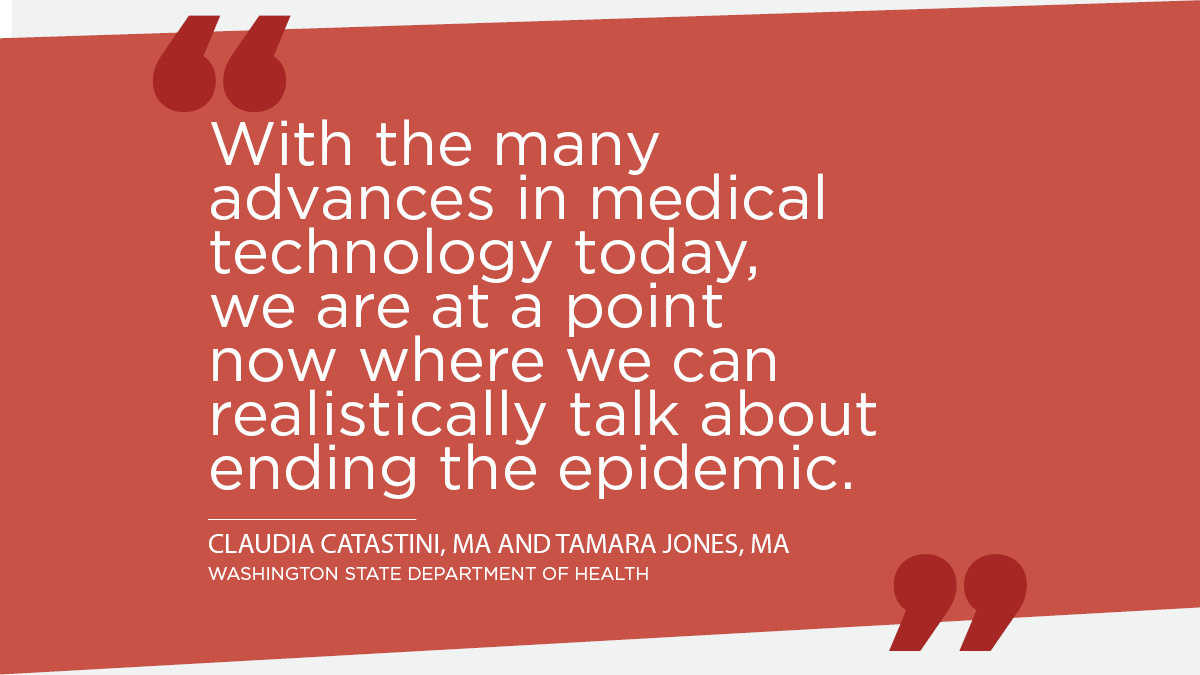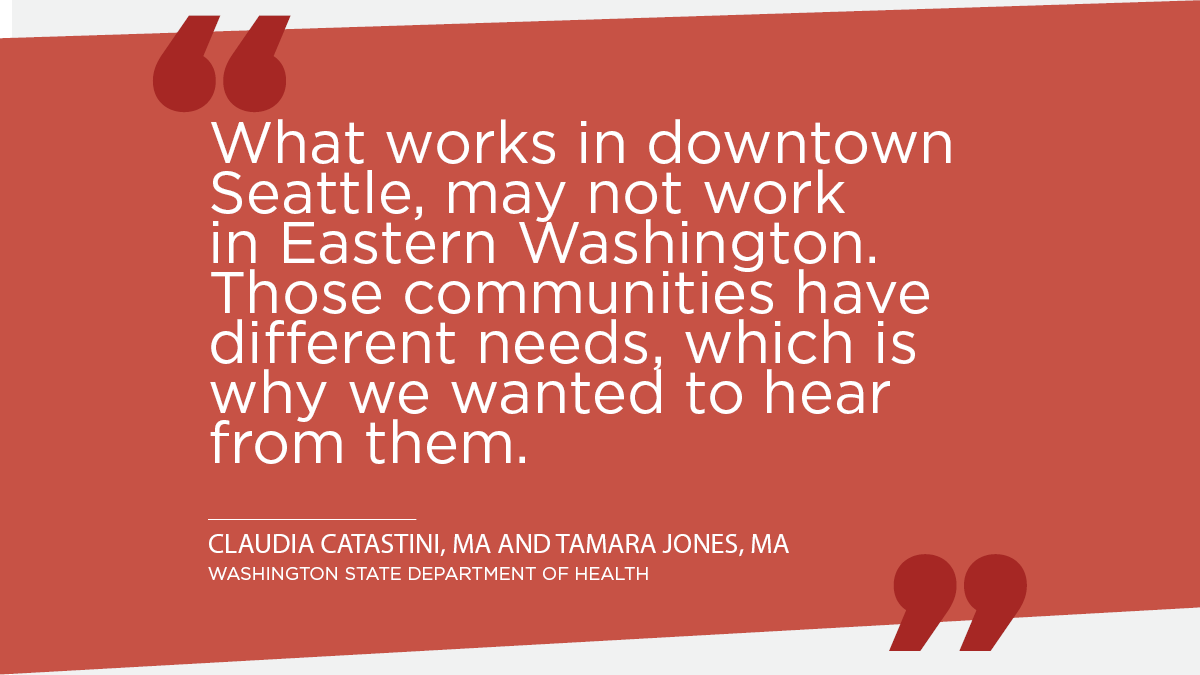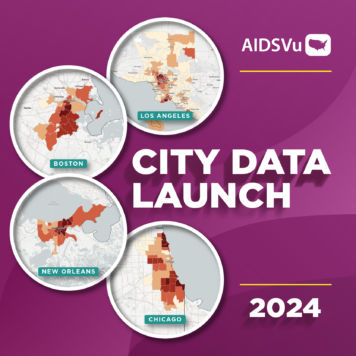AIDSVu recently spoke with Claudia Catastini and Tamara Jones of the Washington State Department of Health about the End AIDS Washington Campaign. Initiated in 2014, the Washington State campaign was one of the first in the U.S.
Q: What was the impetus for the creation of the End AIDS Washington Campaign, and why was it so important for the state to have a campaign?
End AIDS Washington was started by the community – two executive directors of community-based organizations decided to go to the Governor and propose a program to End AIDS in Washington state. The Governor then declared he wanted to build on the partnership between the state Department of Health, local public health, and the community to make it happen. He issued a proclamation on December 1, 2014, and that’s where End AIDS Washington came from.
For background, Washington state has a unique history that positions us to talk about ending the epidemic. We are lucky to have had nearly 30 years of HIV program support in the state. In 1988 our legislature approved funding for programs for both HIV prevention and care for people living with HIV. And, with the many advances in medical technology today, we are at a point now where we can realistically talk about ending the epidemic.
Q: What are the core elements of the End AIDS Washington Campaign?
Our overarching goal is to reduce the rate of new HIV infections by 50 percent by 2020. We have five goals that push us forward and 11 programmatic recommendations that outline how we are going to achieve those goals. The other four goals are:
- To increase the percentage of people diagnosed with HIV who have suppressed viral loads to at least 80 percent by 2020.
- Reduce mortality rates among persons with HIV by 25 percent by 2020.
- Reduce racial, ethnic, and other disparities in health outcomes for those living with or at risk of HIV.
- Improve the quality of life for people living with HIV.
Q: What are some examples of innovative strategies that the Campaign is using to address HIV in Washington?
In 2016 we started taking a different approach to our funding. Traditionally, we would have put out a request for proposal (RFP) to indicate what we had available for funding and ask how respondents would achieve these goals. Instead, we took a broader approach and put out a request for applications (RFA), which allowed local community-based organizations and other stakeholders to come to us with their ideas about what would be best for both care and planning services in their communities. Because Washington state is generally thought of as being a very urban and progressive state, many people forget that although we have an urban core in the Seattle area, ten miles east and west of I-5, is very rural. What works in downtown Seattle, may not work in Eastern Washington. Those communities have different needs, which is why we wanted to hear from them.
Another element that made this approach different is that in the past, we had completely separated care and prevention funding. Now we are moving toward an integrated concept with the clients moving all the way through the care continuum. If someone is at high risk, they get on Pre-Exposure Prophylaxis (PrEP) and have the option of case management. If they are a person living with HIV, they can get linked to case management. Instead of having two different agencies and programs and two different individuals out in the community doing the work, we can integrate prevention and care at the ground level.
An important strategy for our success is our coverage of prevention measures. Washington has a PrEP Drug Assistance Program (DAP) program, which is similar to ADAP, where we are able to support the cost of PrEP for HIV-negative people who have risk factors that expose them to HIV. We were the first state that had a state-funded PrEP DAP. We also cover the cost of HIV testing and STD services, when necessary.
Another element of our program that is very different from how the state previously dealt with HIV is our focus on health disparities. In Washington, we have a group that’s called the “Dr. Robert Bree Collaborative,” or the Bree, which is similar to the U.S. Preventive Services Task Force. The Bree comes out with recommendations that go to the Health Care Authority (HCA), which is the state agency that oversees Medicaid plans and public employee benefits. The HCA then can accept the recommendations and work to implement them. In June 2017 we submitted a proposal for the Bree to look at the health disparities faced by the LGBTQ community. They accepted the proposal. In late 2017 a task force was convened to develop a report to improve LGBTQ+ Health Care Outcomes. In September 2018 the full Bree endorsed the LGBTQ Health Care Report and Recommendations and sent it to the HCA. The HCA has since accepted the report. The HCA, DOH, and other agencies are now working on next steps for implementation.
Finally, we are also looking at modernizing our laws, which were set about 30 years ago. The goal of this statutory modernization is to reduce HIV-related stigma, end HIV, address the criminalization of HIV exposure, and bring our statutes up to today’s science and technology standards.
Q: How does the End AIDS Washington Campaign help to encourage and facilitate coordination between Washington health departments, local providers, community-based organizations, and other local stakeholders?
Our state planning group has 20 members, but that is still not enough representation to cover all the different communities we want to include. To better represent them, we focus on our state’s “villages.” Our DOH planner serves as a coordinator between the state planning groups, the villages, and the staff within our office that specialize in stigma, health disparities, and community engagement. So far this has been an effective method of gathering input and is how we attempt to get more voices heard.
In addition, a number of our staff members focus work with local health departments and community-based organizations and customize the conversation to what that organization’s role is and what they are working on. For example, if a staff member’s job is community engagement, focusing on the mental health effects of HIV on men, their entire reason for existence is to be out and engaged with that community to ensure needs are being met, voices are being heard, and community members are engaged with the processes. Our staff take what they hear and learn out in the field and incorporate it into the programming we do and fund. We also recently hired staff to specifically deal with (1) HIV-related stigma and (2) health disparities. This job is very much out in the field – interacting with different communities and populations to make sure they are engaged in the process.
Even while developing the legislative package, we focused work with the community. In the summer of 2017, we held ten public stakeholder meetings, around the state, that were open to anyone who wished to attend because we wanted to know the needs and options of the public in each community. We also met one-on-one with community-based organizations and different interest groups along the way. We brought that feedback together, spent time going over it, and compared it to what other states were doing. However, all states are starting in different places, so it can be hard to draw on the experiences or programs of a different state. In the summer of 2018, after posting the latest draft, we held another round of public stakeholder meetings to gather even more feedback to make sure we were connecting with the local public health officers and community groups, as well as people who are living with HIV.
Q: What are some examples of successful outcomes that Washington has achieved as a result of its Campaign?
In our world, there is often a lag in time before you see results. However, one improvement we have made is to our HIV care continuum. Getting people linked to care and retained in care is improving. As we continue to improve on that, our viral suppression numbers will continue to improve and continue to cascade. Over the past three years we have seen improvements statewide and among populations who are disproportionately affected. From 2015 through 2017 the statewide percentage of persons linked to care within 30 days of diagnosis increased from 80 to 84 percent. For that same period and population, the percentage with a suppressed viral load increased from 76 to 80 percent. We have also seen improvements in the viral suppression rate among foreign-born Blacks and Hispanics. In 2015, 78 percent of foreign-born Blacks diagnosed and living with HIV in Washington were virally suppressed, while in 2017, that figure increased to 83 percent. For foreign-born Hispanics living with diagnosed HIV in Washington, 73 percent were virally suppressed in 2015, and that figure increased to 79 percent in 2017. For all persons living with HIV in Washington, we have seen a considerable decrease in the HIV-related mortality rate. In 2007, the age-adjusted mortality rate was 2.6 per 100,000 persons, and 10 years later, in 2016, that rate dropped 23 percent to 2.0 deaths per 100,000 persons.
Q: December 1 marked the 30th anniversary of World AIDS Day, and this year’s theme is “Know your status.” How did Washington recognize this important day?
In Washington, awareness day activities are community centered and are grassroots driven. Many community-based organizations and local health jurisdictions, as well as the Governor, marked the day in their own ways. It’s exciting to see organizations and entities across the state conducting awareness day activities in ways that are specific to their communities.




